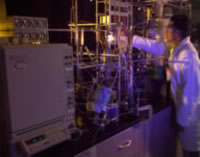
![]()
 |
| Experimental reformation of used lube oils, FSEC H2 Lab, K. Kallupalayam (Photo: N. Waters) |
|---|
Hydrogen is produced on an industrial scale from natural gas by steam reforming. In this process, thermal energy is used to extract hydrogen from the carbon component of natural gas or other hydrocarbons such as propane or naphta.
The steam methane reforming process involves the reaction of natural gas and steam on a nickel catalyst. The first step of the reaction consists of methane decomposing to hydrogen and carbon monoxide. The second step, called the “shift reaction,” reacts carbon monoxide and water (steam) to form carbon dioxide and hydrogen. These reactions occur at temperatures of 200°C (392°F) or greater and require heat input.
Major industrial uses of hydrogen occur at ammonia plants and in the removal of sulfur from petroleum during the refining process. A large-scale application of hydrogen is considered one that uses greater than 1.5 million cubic meters per day (50 million standard cubic feet per day). In these cases, hydrogen is typically produced at the site where it will be used.
